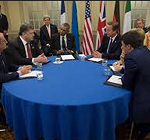As NATO member states met in Wales last week to discuss the situations in Ukraine and Afghanistan, commentators were busy debating the continued relevance of the alliance in the current order. Many argued that the escalating tensions between Russia and western powers over Ukraine have brought about a kind of “Cold War lite,” a throwback to the time when NATO was still relevant, thereby opening up the opportunity for the organisation to regain some of its former prominence.
The pervasiveness of this narrative is at odds with NATO’s actual historical role during and after the Cold War. Contrary to the way it is often represented, NATO has never been a collective security system in the sense of the international community banding together to counter aggression wherever it occurs. Instead, NATO has from the beginning been a collective defence system, which only requires action when an alliance partner is under direct attack – the 9/11 attack on the U.S. was interpreted to be an instance of this. Furthermore, the U.S.’ reluctance to commit itself to mandatory intervention in European conflicts resulted in a treaty that does not automatically trigger a military response to an attack, but instead obliges parties to take whatever action they consider necessary, which may or may not involve the use of armed force. From the outset, therefore, NATO’s collective defence function was severely limited.
Partly as a consequence of this set-up, NATO’s most important function during the Cold War was symbolic. To Western European leaders terrified of communist regimes on their borders, NATO represented U.S. commitment to defend them and prevent encroachment by the Soviet Union beyond the Iron Curtain. Beyond the sense of security it provided, NATO’s potential as an alliance was limited by internal disagreements with regard to funding and foreign policy aims.
It is therefore ironic, considering the common perception of NATO as the quintessential Cold War institution, that its collective defence function was not invoked until 2001. In fact, its largest operations –Afghanistan, Kosovo and anti-piracy actions off the Horn of Africa – have all been conducted in the post-Cold War era.
Importantly, though, it’s most important role continues to be symbolic, especially given the heavy dominance of U.S. leadership, funding and troops in post-Cold War operations. NATO’s ability to coordinate action among its members remains limited, as the deep divisions within over the 2003 Iraq war show, but it gives international activities a sense of legitimacy by providing the illusion of multilateralism, without the difficulty of obtaining UN support. However, this illusion is fragile. Despite its expansion into former Warsaw Pact territory, NATO remains a plurilateral forum, incapable of including voices beyond its limited membership.
This lack of inclusion is most notably demonstrated in the reaction of Russia and others to NATO activities. Where U.S. and European leaders see an attempt at multilateral cooperation, others see a triumphalist hold-over from the Cold War, intent on maintaining American hegemony. These views have not been altered by NATO’s attempts to reinvent itself in the 1990s, and are unlikely to be mitigated, no matter what action the alliance takes on Ukraine or how many new mandates it adopts. Its power as a symbol of international cooperation for its membership is a mirror image of the opposition it encounters as a token of western domination.
However, the continued persistence of these narratives is far from assured. Rising powers such as India and China make for a more complex picture of international security than the idea of NATO versus the rest of the world suggests. Countries such as India now have the economic and military clout to underscore their traditionally non-aligned foreign policy, and are unlikely to be drawn into either NATO or a counter-alliance, requiring a new approach to the idea of security communities. Even the U.S. has shifted its emphasis away from NATO towards bilateral alliances, particularly in South East Asia, blurring perceptions of the importance of plurilateralism. While NATO’s symbolic power still endures, a rapidly changing international order and new security configurations could make it obsolete in the near future, as new narratives take its place.
Katharina Obermeier is an intern with Gateway House: Indian Council on Global Relations. She is currently pursuing an MPhil degree in International Relations at the University of Oxford.
This blog was exclusively written for Gateway House: Indian Council on Global Relations. You can read more exclusive content here.
For interview requests with the author, or for permission to republish, please contact outreach@gatewayhouse.in.
© Copyright 2014 Gateway House: Indian Council on Global Relations. All rights reserved. Any unauthorized copying or reproduction is strictly prohibited


